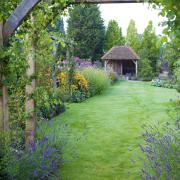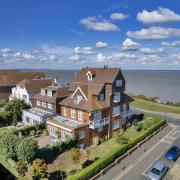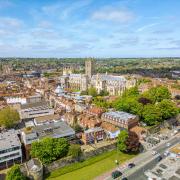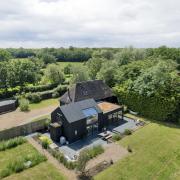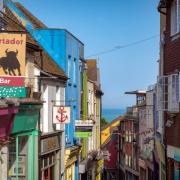A familiar sight in the coastal village of Dungeness, Derek Jarman’s Prospect Cottage has long attracted visitors to its haunting coastal garden. Now, 30 years after its famous inhabitant’s death, its interiors have been captured in a beautiful new book. Its author, photographer Gilbert McCarragher, tells the story of his own relationship with the house and its history
While its garden is well-trodden, Prospect Cottage’s interiors remained largely private after Derek Jarman, the filmaker, artist and gay activist, died in 1994 from an AIDS-related illness. He had bought the tar-clad, clapboard Victorian fisherman's hut in 1986, having spotted it when he stopped to buy fish and chips from the Pilot Inn after a day filming locally with the actress Tilda Swinton. Over the years, he lived and worked here, filling it with a wealth of art, beachcombed stones and driftwood and repurposed objects.

The photographs and essays in my book explain my experience of spending time at the house at a transitional point in its history, revealing the care given to it by Derek’s companion, Keith Collins, across the 24 years following Derek’s death before, sadly, Keith passed away.
Keith was a much loved member of our small Dungeness community (I'd moved here myself in 2008). He continued to live between London and Dungeness following Derek’s death, even working for a number of years on the fishing boats off the coast. My work on the book began in 2018, shortly after Keith became unwell with a previously undiagnosed brain tumour. Friends and neighbours were understandably very concerned for him, and for what his illness might mean for Prospect, which Keith had so dutifully tended to for so many years. During that uncertainty, I was asked to photograph the cottage, to record how it was in that moment.
Arriving at the front door of Prospect on the first day of my shoot, I kicked and pulled at the door in the sequence I had been carefully instructed to follow. After a muttered prayer and a few gentle kicks, the door finally gave way and I walked in. I had been in the cottage many times before this, but each of those times my experience of the space had been guided by Keith. This time I was alone, and that played heavily on my mind. There was no music coming from the Garden room, no tea, no tall tales from Keith, no laughter. There was just silence, interrupted occasionally by the sound of birds outside, dancing on the corrugated roof.

I unpacked my camera bag and went about the task of recording the cottage. In a very workman-like manner, I photographed each wall and corner as a true inventory: eight shots in each of the rooms: bedroom, studio, front room, spring room (a study-cum-bedroom), with the kitchen, a bathroom and the garden room at the back and the loft at the top of the house. I quickly realised, however, that, while capturing “everything” as was required, these shots missed what Prospect Cottage was really about. They would serve their intended purpose, but to me it felt as though the photographs were not conveying anything of the mood of the house—what it felt like to spend time there.
I finished up the inventory shots, then spoke about my concerns with a dear friend and fellow neighbour in Dungeness, who was also a close friend of Keith’s and who was working with him on the arrangements for what should happen to Prospect if things did not work out as we all hoped they would. She agreed with me that the cottage deserved more than the orderly photographic inventory we had been working on.

We discussed how Prospect was at a pivotal moment in its history, each of us concerned that Keith’s legacy and his work protecting the cottage for all those years might be washed away by whatever changes were coming. We both felt that we couldn’t let this happen, and so we set about making arrangements for me to return to the house to document what it was actually like being there.
My return awhile later was much more of a journey of exploration and experimentation, as I allowed myself to be led round Prospect by the mood, the light, my memories of the house before Keith died, the weather…whatever. The experience allowed me to capture and to hold on to my sense of what this special place meant to me, a place I had known since I first visited it as an art student in the 1990s. It was an incredible privilege to have this experience continue over the next several years across countless visits, which allowed me to feel, to photograph and to document Prospect in all shades of light and in all seasons.

Each time I was to return to the house, friends would ask me, 'Surely you have photographed everything there is to capture at Prospect now?', and occasionally I might have felt the same way. Yet, every time I entered the cottage, it would draw me in completely and make me look at something in a new way, or make me double-back on myself and force me to re-examine something or to reconsider a shot I had taken before, perhaps from a different vantage point or angle.
One afternoon I found myself pulled down on my knees by some peculiar markings I noticed on the floor, only to then spend hours examining the long gone Tetris-like woodworm furrows in the floorboards of the house. On another visit, as I was melting in the extreme heat of a Dungeness summer, I found myself “melting” away the world of Prospect around me, trying to navigate it through Derek’s magnifying glass, which I had borrowed from his writing desk in the Spring Room—its lens’s rapid fall from focus to softness liquified almost everything it framed. The house had stayed hidden for so many years behind its net curtains (Keith had added them after Derek's death to deter garden visitors from peering in), yet even with these now down, the house still managed to conceal itself, revealing something entirely new only when it wanted to. Even if I had looked at what I was seeing a hundred times before, I often felt I had somehow not yet seen it.

Originally I planned to photograph the inside of the cottage only, with glimpses of the garden through windows and doorways, partly because I felt the garden had been so extensively photographed that there was little point me adding to that discourse. As time went by, though, I realised I needed to photograph outside Prospect as well, as otherwise I would be telling just half the story and not revealing the dialogue that was happening between the inside and the out.
My journey outdoors surprised me further, by showing to me that a lot of the intimate moments and connections that I had observed and photographed inside the cottage were echoed in its garden and in the fabric of the building itself. The sentinel posts that keep watch inside the house, for example, appear again outdoors—often in sight of each other, almost as if forming a protective guard or wall. I keenly felt this spirit of protection while photographing inside Prospect Cottage too—such as in the large boots in the bedroom, which stood next to and seemed to watch over a smaller pair of shoes. Outside, I noticed that a cracked chimney pot had been tethered to a stronger partner, which lent its strength to the other to stop it from toppling over.

Derek’s garden grew from the planting of a single dogwood against a found piece of driftwood that he staked beside it to provide it the shelter it needed to survive—and my time at the house revealed to me that Prospect Cottage and its garden continued this sentiment. It is a place where people and objects have cared for, and continue to care for, one another. It is a community, a grand assemblage—perhaps Derek’s greatest—which, when viewed as a whole, can be considered a work of art in its own right.
The future of Prospect Cottage was secured for the nation in 2021 by Art Fund and Creative Folkestone with the generous support of over 8,100 donations from the public. Guided visits are now offered on a limited basis - booking in advance is essential. creativefolkestone.org.uk
Prospect Cottage: Derek Jarman’s House with photography and words by Gilbert McCarragher is published by Thames & Hudson, £25.







